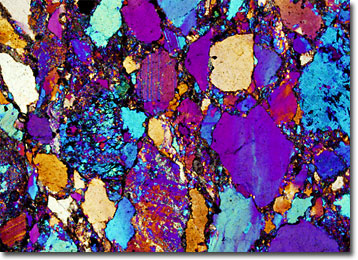Polarized Light Microscopy Digital Image Gallery
Graywacke
Relatively dark in color, graywacke is composed of rounded, sand-sized pebbles cemented together by a matrix that predominantly consists of clay minerals, chlorite, and sericite. The pebbles in the sedimentary rock typically comprise feldspar and quartz.

Graywacke formation is associated with landslides that occur underwater, which carry fragmented rock, sand, silt, and other debris away from the continental periphery and into the deep waters of the ocean. Indeed, this rock type is particularly linked to subduction zones, where the collision of the oceanic and continental lithospheres results in frequent sediment release. Since in such unstable locations minerals, rocks, and other particles do not have much time to sort themselves out before they accumulate, when graywacke is formed from the materials, they seem to be mixed haphazardly throughout the rock, which has resulted in its alternate name, dirty sandstone.
Beds of graywacke rock generally range from only a few inches thick to a few feet thick. However, graywacke formations may be much larger, sometimes spanning thousands of feet and exhibiting repetitive graded bedding. Cyclic sequences of graywacke with other rocks, such as shale or other sandstones, are also fairly common occurrences. Graywacke is found in and around many mountain belts, including the Italian Apennines, the Alpine flysch, and the ranges of the northwest United States.
